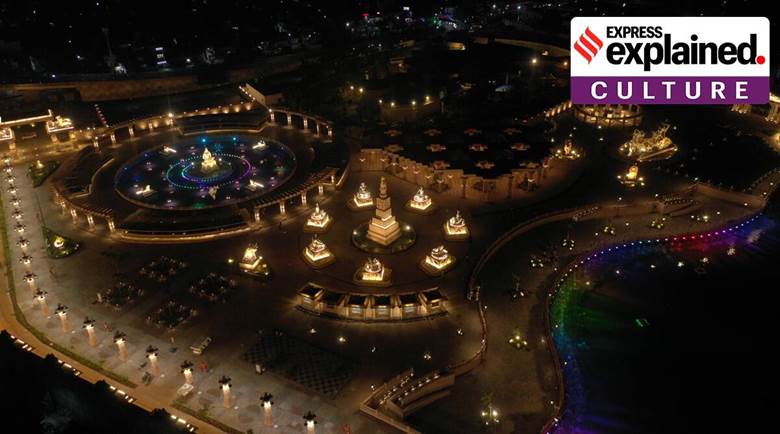Description

Copyright infringement not intended
Context: Prime Minister inaugurated the Mahakaleshwar Corridor, constructed in Madhya Pradesh’s Ujjain at a cost of Rs 350 crore, on October 11.
Details:
- Mahakal Maharaj Mandir Parisar Vistar Yojna is a plan for the expansion, beautification, and decongestion of the Mahakaleshwar temple and its adjoining area in Ujjain district.
- Under the plan, the Mahakaleshwar temple premises of around 2.82 hectares is being increased to 47 hectares, which will be developed in two phases by the Ujjain district administration.
- This will include the 17 hectares of Rudrasagar lake. The project is expected to increase annual footfall in the city from the current 1.50 crore to nearly three crore.
- One of the aspects of the Vistar Yojna’s first phase is a visitor plaza with two entrances or Dwaars — the Nandi Dwaar and the Pinaki Dwaar.
- The first phase is complete and will be inaugurated by PM Modi on October 11.
- The second phase, pegged at Rs 310.22 crore, includes expansion of the eastern and northern fronts of the temple. It also includes development of various areas of Ujjain city, such as Maharajwada, Mahal Gate, Hari Phatak Bridge, Ramghat façade, and Begam Bagh Road.

About the temple:
- Mahakaleshwar, which means the ‘Lord of time’, refers to Lord Shiva. As per Hindy mythology, the temple was constructed by Lord Brahma and is presently located alongside the holy river Kshipra.
- Mahakaleshwar Jyotirlinga in Ujjain is one of the 12 jyotirlingas considered the most sacred abodes of Shiva.
- As per records, the temple’s Mahakal Lingam is believed to be Swayambhu (self-manifested).
- The shrine is revered as one the 18 Maha Shaktia Peeth in India.
- The temple in its present form was built by the Maratha general Ranoji Shinde in 1734 CE.
- Before Independence, the Dev Sthan Trust used to look after the temple. This was replaced by the municipal corporation of Ujjain post-Independence. The collectorate office of Ujjain district now manages the administration of the temple.
- A local legend says that there once was a king called Chandrasena who ruled Ujjain and was a Shiva devotee. The Lord appeared in his Mahakal form and destroyed his enemies. Upon the request of his devotees, Shiva agreed to reside in the city and become its chief deity.
- In the early part of the Meghadutam (Purva Megha) composed in the 4th century, Kalidasa gives a description of the Mahakal temple. It is described as one with a stone foundation, with the ceiling on wooden pillars. There would be no shikharas or spires on the temples prior to the Gupta period.
Jyotirlingas in India:
- Puranas say that Lord Shiva pierced the world as an endless pillar of light, called the jyotirlinga.
- There are 12 jyotirlinga sites in India, considered a manifestation of Shiva. Besides Mahakal, these include Somnath and Nageshwar in Gujarat, Mallikarjuna in Andhra Pradesh, Omkareshwar in Madhya Pradesh, Kedarnath in Uttarakhand, Bhimashankar, Triyambakeshwar and Grishneshwar in Maharashtra, Viswanath at Varanasi, Baidyanath in Jharkhand, and Rameshwar in Tamil Nadu.
- Mahakal is the only jyotirlinga facing the south, while all the other jyotirlingas face east. This is because the direction of death is believed to be the south. In fact, people worship Mahakaleshwar to prevent an untimely death.
- In the 13th century, the temple complex was destroyed by Turk ruler Shams-ud-din Iltutmish during his raid on Ujjain.
- The present five-storeyed structure was built by the Maratha general Ranoji Shinde in1734, in the Bhumija, Chalukya and Maratha styles of architecture. A century later, its marble walkways were restored by the Scindias.
Ujjain-Historical significance:
- The city of Ujjain was also one of the primary centres of learning for Hindu scriptures, called Avantika in the 6th and 7th centuries BC.
- Later, astronomers and mathematicians such as Brahmagupta and Bhaskaracharya made Ujjain their home.
- Also, as per the Surya Siddhanta, one of the earliest available texts on Indian astronomy dating back to the 4th century, Ujjain is geographically situated at a spot where the zero meridian of longitude and the Tropic of Cancer intersect.
- In keeping with this theory, many of Ujjain temples are in some way connected to time and space, and the main Shiva temple is dedicated to Mahakal, the lord of time.
- In the 18th century, an observatory was built here by Maharaja Jai Singh II, known as the Vedh Shala or Jantar Mantar, comprising 13 architectural instruments to measure astronomical phenomena.
https://indianexpress.com/article/explained/what-is-the-rs-600-crore-redevelopment-plan-for-ujjains-mahakaleshwar-temple-8179285/
















